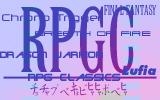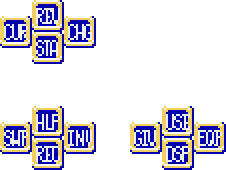
 |
|
|
 |
| Index: |
What is Shining Force Gaiden: Final Conflict?
The story of Shining Force Gaiden: Final Conflict takes place between Shining Force and Shining Force II for the Genesis console. In it, many characters from both games appear to participate in your battles, the story, or both. It is the third and final installment of the Shining Force Gaiden series and the last to appear on the Sega Game Gear.
As you'll notice throughout this shrine, Japanese names are given for nearly everything in the game: the game was never released in English and because of the script's compression, an unofficial translation has yet to be released.
Finally, the game has no "walk-around" mode that the two Genesis installments of the Shining Force series do; in other words, you watch the story and participate in battles rather than exploring towns and other environments.
Game Controls
- Out-of-Battle: When out of battle, Button 2 will confirm your actions and Button 1 will cancel them, much like many other RPGs. The directional pad, naturally, moves either the menu cursor or your characters around the screen.
- In-Battle: The In-Battle controls are very similar to the Out-of-Battle controls with a few exceptions which will be discussed later in detail. Button 2 still confirms, Button 1 cancels, and the directional pad moves the cursor and party members.
Camp:

- REV (Revive) - Revive a character at the cost of their level multipled by 20. If your character is promoted, ten levels are automatically added regardless of the level of the character at promotion.
- CUR (Cure) - Remove the cost of a status ailment--for a price.
- CHG (Change) - Promotes one of your characters. Every character that joins your party prior to Eric the Dragonman can be promoted once they reach level 10, but in order to maximize their statistics, promoting them at level 20 is a better idea. Your characters keep any bonuses to their statistics in the 10 levels they gain.
- STA (Status) - Shows the status of individual members of the force.
- SWP (Swap) - Rearrange the 12 members of your team and swap them with the inactive members.
- REC (Record) - Saves your progress up to this point of the game.
- GIV (Give) - Transfer items from one force member to the other.
- USE (Use) - Use one of your force members' items.
- EQP (Equip) - Equip an item in your inventory.
- DSP (Dispose) - Throw an item in your inventory away.

- BTL (Battle) - Attack an enemy with your equipped weapon
- CST (Cast) - Cast a magic spell (only applicable for those that know spells, of course)
- HLD (Hold) - Forfeits that particular character's turn until their next turn. Your character usually goes a second time faster if they waited for their first turn as opposed to acting.
- GIV (Give) - Transfer items from one force member to the other; only works for party members adjacent to you.
- USE (Use) - Use one of your force members' items; the range and effect depends on the item.
- EQP (Equip) - Equip an item in your inventory; this does not use a turn.
- DSP (Dispose) - Throw an item in your inventory away; this does not use a turn.

- BUY (Buy) - Purchase an item from the salesman.
- SEL (Sell) - Sell an item from the salesman.
- BGN (Bargain) - Buy one of the rare items you didn't pick up from the battlefield.
- RPR (Give) - Repair a broken item.
As your characters gain Experience levels by performing actions in battle, they will gain a Level and will their statistics will increase. Certain characters have higher statistics than others in certain areas, so it is up to you to decide which characters to use based on which strategy you find most comfortable. Here is a list of these statistics and what each does:
 |
HP (Hit Points) | When attacked by the enemy, your character loses HP, and when this amount reaches 0, the character will be defeated. |
 |
MP (Magic Points) | When casting spells, MP is consumed. If a characte runs out of MP, they can no longer cast spells. |
 |
Attack | This statistic determines the amount of damage done by the Attack command in battles. |
 |
Defense | This statistic determines the amount of damage received by the attacks of enemies (excluding magical attacks). |
 |
Agility | Agility serves two uses: first, it determines how quickly you gain turns in battle, and second, it determines how likely a character is to succeed in an attack or dodge an enemy's attack. |
 |
Movement | Movement determines how far your character can move when it is their turn. |
 |
Experience | For doing offensive or supportive actions in battles, characters earn EXP; when their EXP level reaches 100, they gain a level and all of their statistics increase. |
 |
Level | This just indicates the amount of times your character has gotten 100 EXP. On Level 10, characters can be promoted, but it is best to wait until level 20 to promote characters; this allows them to learn spells easier while promoted, and when they are promoted, their preset statistics will be higher than if you had promoted them as soon as possible. Level also determines the amount of experience points gained for offensive actions in battle. |
| Notes: If you save your game just before a character levels up, you can reset if the gain in statistics is not satisfactory. Generally, you should only accept a level-up if your character gains roughly 3 points each level. | ||
Battles
Victory is attained according to certain conditions in battles. Generally, you can win each battle by one of three ways: defeating every enemy on the battle field, defeating one particular enemy on the battlefield, or reaching a certain location regardless of the enemies on the battle field. Naturally, these enemies will be guarding your destination.
Defeat occurs only when Ian, the main character (SDMN or HERO), falls in battle. Retreat is possible using either an Angel Wing, the Speed Ring, or the spell Egress in battle. You should retreat if you don't have the means to win the battle.
Your turn: - When it's your party member's turn in battle, the ground will flash in locations on which they can move. use the directional pad to move these characters, then press Button 2 to bring up the action menu once you've picked a location. If you stray from your spot where the last turn ended, press Button 1 to return and to move the cursor elsewhere, such as on other characters or enemies to view their statistics. Once you do any of the commands in the Action menu, your turn is over for that character. When you press B to return to your position in battle and can freely move the cursor, press Button 2 on a blank space to bring up the following menu:

- STA (Status): See the status of your force members.
- SPD (Speed): Set the message speed of in-battle message displays.
- SAV (Save): Saves the game in the current position and allows you to quit.
- SWI: Toggles whether or not in-battle messages display.
Their turn: - When it's the enemy's turn to move a unit, the enemy moves in a manner very similar to your own when it's your turn, only none of the options are shown.
Battle Strategy
Once you have over 12 members of the Shining Force, you will need to select which ones to take with you, so party formation becomes an issue quickly. While it is up to the player to decide a strategy based on the battle, in general, you want to have a balance of characters; some fighters, some healers, some mages, etc. The reason you have a team is because your characters need to work together in order to be successful.
Always anticipate what your enemy could do, especially with mages. Never approach mages bunched close together or you might suffer some serious consequences and the loss of the battle as a result. You have the ability to see your enemies' statistics, so do so and plan ahead.
Beware Land Effect, which decreases your mobility with the exception of certain flying characters.
Using Items
While in battle, you can use consumable items (Anything that's not a Ring or a Weapon) and permanent items (anything that is a ring or a weapon). Consumable items disappear after one use, so be sure you want to use them when you do. It is very possible to beat the game without using any of the best and rarest items, so consider trying to do so and conserving items until the final battle to be the most efficient.
When using permanent items, spells are cast in battle. Weapons that cast spells can be used as many times as you please, but if you cast a spell using a ring there is a chance that ring could crack. If it does, have it repaired immediately, because if you use it again it may break and it will be gone permanently. You can only find one of each ring in the game.
When using stat-boosting items, wait until after your characters have been promoted in order to ensure the best gain of statistics. Since your characters' statistics reset after promotion anyway, using them before-hand is just a waste.
Equipping Items
In general, you want to equip the weapons which most greatly improve your statistics with two exceptions. Knights and Paladins may want to sacrifice some Attack points to use a spear and attack a distance, and the variety of Mages, Wizards, Healers, and Vicars may want to equip a Guardian staff rather than a stronger weapon. You usually won't use the spell-casters for melee attacks.
Ocassionally, you will come across an item that is cursed. Once you equip this item, you can't remove it until having a priest undo the spell or, with a lot of luck, casting the Detox spell on the character.
|
|